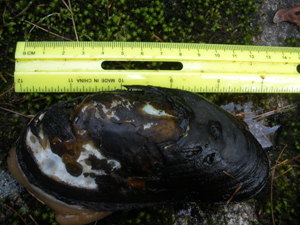Brittany Laginhas , Fifth Year Masters
 My research interests have fluctuated from evolution to stream ecology over the course of my academic career. In my first year, I began research in the Foster/Baker lab. During this time, I studied the life history traits of Gasterosteus aculeatus, more commonly known as the threespine stickleback. In my sophomore year, I shifted focus towards conservation policy. At this time, two other Clark students and myself summarized Canadian federal and provincial legislation in order to determine the protection status of endangered species. By the end of my junior year, I narrowed down my interests to stream ecology, with a specific focus on the biology of freshwater mussels.
My research interests have fluctuated from evolution to stream ecology over the course of my academic career. In my first year, I began research in the Foster/Baker lab. During this time, I studied the life history traits of Gasterosteus aculeatus, more commonly known as the threespine stickleback. In my sophomore year, I shifted focus towards conservation policy. At this time, two other Clark students and myself summarized Canadian federal and provincial legislation in order to determine the protection status of endangered species. By the end of my junior year, I narrowed down my interests to stream ecology, with a specific focus on the biology of freshwater mussels.
Freshwater mussels are among the fastest declining species in the world. Freshwater mussels interest me not only for their much needed conservation, but also because of their importance to stream ecosystems. They make up a large amount of biomass in the stream; therefore, they are an important food source to many organisms. Also, mussels are suspension feeders, which means they improve water quality, too. Despite their importance, very little is known about them. In order to gain a better understanding of their basic biology, during my senior year, I began studying the effects of flow and sedimentation on freshwater mussels. Last fall, I took Freshwater Ecology with Dr. Sobczak, a limnologist and professor at the College of the Holy Cross. This class allowed me to develop an inter-university collaboration, which has provided me with additional resources and information critical to improving my research.
For my master’s research, I have continued working with freshwater mussels. Currently, I am conducting a demographic survey of the Eastern Pearlshell, Margaritifera margaritifera, located in the East Branch Swift River in Petersham, Massachusetts. Although Margaritifera margaritifera is not currently protected in Massachusetts, it is deemed endangered by the IUCN. Furthermore, in Europe, it has been warranted protection under the Bern Convention and the Habitats Derivative. Ultimately, the purpose of this survey is to collect demographic information that will be useful for the long-term monitoring of Margaritifera margaritifera in the East Branch Swift River, but also to contribute to the development of conservation and management of this species worldwide.

Outside the lab:
Most of my time outside the lab is spent on other research projects. In the past, I have been involved with research at Brown University. I studied the life history traits of Arabidopsis thaliana, a small mustard plant native to Europe. Along with studying life history traits, I have started an independent project that uses bioclimatic variables to explain seed size variance between ecotypes. Over the past two summers, I have worked with a local environmental consulting company on an ongoing effort to eradicate and manage invasive aquatic plants in various places in the northeastern United States. When I am not working on various research projects, I enjoy cooking/baking, being outdoors, and playing soccer.